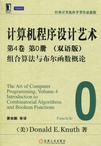计算机程序设计艺术
出版时间:2010-8 出版社:机械工业出版社 作者:Donald E.Knuth 页数:432 译者:黄林鹏
Tag标签:无
内容概要
本册揭开了计算机程序设计艺术目前最长一章的序幕,而论述组合算法的这章将包括完整的3卷。非正式地说,组合算法是对量非常大的对象,如alan或图元素,进行高速处理的技术。组合模式或排列技术可解决大量的现实问题,而处理这些问题的现代方法比起以前所采用的直接过程快上千倍。本册是后面章节的基础,这里首先讨论的是组合学的本质,接着介绍在计算机内部如何有效处理0和1的基本思想,包括布尔基础和布尔求值等内容。如常。为了强化作者的阐述,书中包括了大量细心组织、包括使用说明和详细解答的新的习题。
作者简介
作者:(美国)唐纳德 E.克努特(Donald E.Knuth) 译者:黄林鹏 等唐纳德 E.克努特,Donald E. Knuth,中文名高德纳。由于在算法和程序设计技术方面的先驱性工作,由于发明了计算机排版系统TEX和METAFONT。以及由于他的富于创造力的、影响深远的论著,Knuth名扬全球。作为斯坦福大学计算机程序设计艺术的荣誉退休教授,Knuth现在正投入全部的精力来完成这些分册以及包含这些分册的七卷著作。
书籍目录
PREFACE iii PREFACE TO VOLUME Chapter 7 Combinatorial Searching 7.1 Zeros and Ones 7.1.1 Boolean Basics 7.1.2 Boolean Evaluation Answers to Exercises Index and Glossary 译者序 前言 第4卷前言 第7章 组 合 搜 索 7.1 0和1 7.1.1 布尔基础 7.1.2 布尔求值 习题答案
章节摘录
插图:Aren't we missing the point if we merely shuffle such questions off to machines, to be solved by brute force instead of by rational thought? George Brewster, writing to Martin Gardner in 1963, expressed a widely held view as follows: “Feeding a recreational puzzle into a computer is no more than a step above dynamiting a trout stream. Succumbing to instant recreation.”Yes, but that view misses another important point: Simple puzzles often have generalizations that go beyond human ability and arouse our curiosity. The study of those generalizations often suggests instructive methods that apply to numerous other problems and have surprising consequences. Indeed, many of the key techniques that we shall study were born when people were trying to solve various puzzles. While writing this chapter, the author couldn't help relishing the fact that puzzles are now more fun than ever, as computers get faster and faster, because we keep getting more powerful dynamite to play with. Further comments appear in the author's essay, “Can toy problems be useful?”, originally written in 1976; see Selected Papers on Computer Science (1996), 169-183.Puzzles do have the danger that they can be too elegant. Good puzzles tend to be mathematically clean and well-structured, but we also need to learn how to deal systematically with the messy, chaotic, organic stuff that surrounds us every day. Indeed, some computational techniques are important chiefy because they provide powerful ways to cope with such complexities. That is why, for example, the arcane rules of library-card alphabetization were presented at the beginning of Chapter 5, and an actual elevator system was discussed at length to illustrate simulation techniques in Section 2.2.5.A collection of programs and data called the Stanford Graph Base (SGB) has been prepared so that experiments with combinatorial algorithms can readily be performed on a variety of real-world examples. SGB includes, for example, data about American highways, and an input-output model of the U.S. economy; it records the casts of characters in Homer's Iliad, Tolstoy's Anna Karenina, and several other novels; it encapsulates the structure of Roget's Thesaurus of 1879; it documents hundreds of college football scores; it specifies the gray-value pixels of Leonaxdo da Vinci's Gioconda (Mona Lisa). And perhaps most importantly, SGB contains a collection of five-letter words, which we shall discuss next. The five-letter words of English. Many of the examples in this chapter will be based on the following list of five-letter words: aargh, abaca, abaci, aback, abaft, abase, abash……zooms, zowie. (8)(There are 5757 words altogether——too many to display here; but those that are missing can readily be imagined.) It's a personal list, collected by the author between 1972 and 1992, beginning when he realized that such words would make ideal data for testing many kinds of combinatorial algorithms.
图书封面
图书标签Tags
无
评论、评分、阅读与下载
用户评论 (总计24条)
- 书很好,真的很好,
学计算机的同学手头必备的一本书。
只是我不明白为什么没有第四卷第一册。。。。。。。。。。。。
找了好久也没找到。 - 经典的算法书
- 30年构造出来的经典,算法中的bible
- 很经典的书,双语版就更方便阅读和理解了。什么时候有第4卷第1分册的双语版呢?急盼
- 在美国学计算机的朋友点名要此书
- 双语版本,买来收藏,前三卷没货,等待中
- 这本书绝对是计算机领域的经典书籍
- 前三卷很早以前就买了,但到现在还没有看完。我把这几卷是当作闲书来看的,同时还带点收藏的意思。
- 买这本书是为了收藏。英文E书看过了,留一本放在手头。但是印厂的纸张太次了,翻看几回恐怕得碎了。
- 对专业很有用。
- 图灵奖大师数十年心血,好好读吧,嘿嘿
- 还算可以,就是第四卷内容略显凌乱
- 书的内容自不用多说,当当的服务真是一流
- 除了纸张有点粗糙之外这本书无可挑剔,内容自不必说,高德纳的书都是精品,稍有点难懂,作者的大构思很难一下子看明白,要多翻几遍!总之,是一本好书,值得推荐!
- 这书真的是不懂,一点都不懂
- 厚实,纸张还可以,就是字有些密集看上去不是很舒服
- 过多的数学介绍,有点难懂
- 纸张黄黄的,整本书松松垮垮的,页边也不平整光滑,不像是正版书,而且竟然不是苏运霖翻译的。
- 很好,前3冊的翻譯版反而難買
- 质量很好,来得很快,不错,不错
- 很好的一本书,讲解让我有一种全新的感受,翻译得也蛮不错
- 现在已有第四册A啦,所以这本书完全被覆盖了。
- 内容不用说,大家都知道,大师的作品,不过这本书的纸质实在不敢恭维,差的也踏糊涂,拿到书的第一感觉就是这是盗版的,不过看了别的地方对这本书的评价也就释然了,这本书的纸质确实差。
- 怎么能没货呢 快进货
